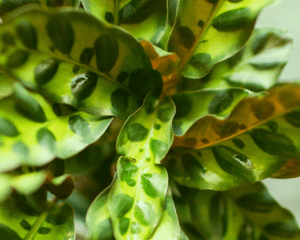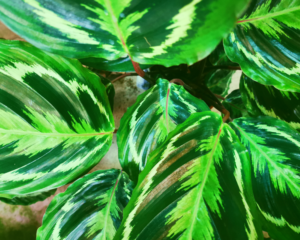If you are looking for a great houseplant in low light areas, you might want to consider a calathea. Calathea, also known as ‘Prayer Plants’, come in many variations ranging in color and striking patterns. Rainbow Gardens generally carries many different types of calathea making it easy to find one that suits your indoor aesthetic. Today I’ll give you my “Quick Look” at calathea and a rundown on their care, along with some calathea “eyecandy” along the way. P.S. Our Bandera location will have their Calathea orbifolia on sale this weekend! (Regular price $14.99, sale price $6.88, valid May 28, 29 30).


Calathea Quick Look
Type of Plant: Indoor Houseplant, Evergreen
Light Requirement: Indoor low light, indirect bright light, bright artificial indoor light okay, avoid direct sunlight.
Soil Requirement: Quality potting soil rich in organic matter, well-draining
Water Usage: Consistently moist soil, but no standing water
Climate preferred: High humidity(see notes below)
Average Mature Growth: 6”- 24” T x 6”- 18” W (depending on variety and final container size)
Toxicity: Generally safe around pets (always consult your vet)


Care for Calathea
There are many “trendy” plants that you may see appearing to live happily in lowlight, indoor spaces on certain social media sites (not ours) that in “real life” actually need much more light to survive and thrive. Calathea can actually do what those other plants feign to do. They can make the perfect office plant, or live tucked in a corner of a living room that receives indirect bright light. This houseplant doesn’t have to, and shouldn’t be, pressed up against a window to get the light it needs.
For the most part, just like with other plants, if you are taking care of your calathea properly you won’t have to worry too much about pests or disease issues. Root rot can be kept at bay with proper watering (keeping soil moist but not soggy) and planting in a container with adequate drainage holes. Dehydration is kept at bay by not underwatering and providing enough humidity. Humidity can be achieved by placing the pot of your calathea on top of a shallow tray full of small pebbles and water. You can use the drainage saucer of pots for your humidity tray. Spider Mites are the most common issue you may experience, but they are easily kept at bay by following proper care of your plants (watering tips above). If you are observing your plant as you should be often, you will be able to catch pests problems early and ward them off with: a water rinse, a wipe of the leaves with a soft towel, or a towel saturated with isopropyl alcohol. You can also spray with a diluted neem oil solution as a preventative.
Come on in and find the perfect calathea for your indoor space! It’s Tax Free Weekend starting May 28, running until the 30th!
~The Happy Gardener, Lisa Mulroy


My calathea leaves are curling up around the edges turning brown
This sounds like a watering issue. The problem is, it can either be too much or too little. What is your watering schedule? Does your pot have adequate drainage? Are you feeling the soil with your finger (sticking it in to about the 2nd knuckle) before watering? If soil sticks to finger, wait to water. If it falls freely, water. Make sure when watering to water thoroughly to where it runs from the bottom of the pot. Wait til it stops before placing it back on a saucer.